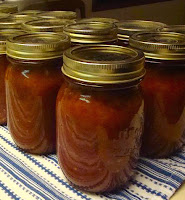Lately, I have noticed that I have been writing what I think I should write; what I think people will want to know about or read. I entered recipes in quite a few food contests that actually received good reviews (including having 2 recipes chosen as Editor’s picks at Food52.com and one recipe chosen for Foodbuzz’s Flavor of the Month) which drove traffic to the blog, but they seemed hollow to me; devoid of personality. I now realize the problem was that I had gotten away from my true love which is writing about food. Not just recipes and trite blurbs of historical facts or nutritional benefits, but the experiences and revelations that make the recipes sing.
 |
| The Mind Purge |
 |
| Grams cooking in 1948 (in the sun, not the kitchen) |
My undocumented pieces of literary genius always have Scrabble-winning vocabulary and segues that are smoother than hand-spun Tibetan silk which disappear into a misty vapor the millisecond I sit down in front of my laptop. Looking for inspiration, I log into the font of fodder known as Facebook and immediately get lost in the dizzying array of notions for blog posts. My mind sprints ahead from one potential post to another like a chess player thinking 5 moves ahead. Alas, no posts magically appear in the editing pane.
For this post, I employed a new tactic. While wiping down the kitchen counters, inspiration struck. Thinking quickly, I grabbed my cell phone and recorded my thoughts. Fourteen voice memos later, I had a clean kitchen, a clear mind, and the respectable makings of a blog post!
While this exercise in self-actualization has given rise to the epiphany about my writing which in the future will reflect more of my own personality, this is still a food blog. Thus, I feel compelled to include a recipe at this juncture; something simple and delicious (with a beat you can dance to.)
Since my birthday is usually heralded by the seasonal return of chimney swifts, gardenia blooms, and fresh strawberries, we should celebrate the sweet yet tart berries by accentuating them with sour cream and brown sugar. Chef James Haller, author of Cooking Brilliantly Without Recipes, is credited with first serving strawberries this way at his restaurant the Blue Strawberry in Portsmouth, New Hampshire.*

1 pint fresh strawberries
½ cup sour cream
½ cup brown sugar
Quickly and gently rinse strawberries (don't let them get soggy!) and place them in a bowl, and place sour cream and brown sugar in (separate) bowls. First dip the strawberries into sour cream and then in the brown sugar. Clear your mind and let the flavors drift over you like a gentle zephyr!
*See, I even managed to work in a little history too.


























